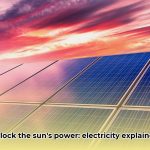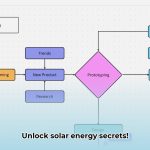Harness the power of the sun! This guide covers everything from the science behind solar energy to the practical steps of getting panels on your roof. Whether you’re a curious beginner or ready to make the switch, we’ve got you covered.
Understanding Solar Energy
What is Solar Energy?
Solar energy is the radiant light and heat from the sun. Unlike fossil fuels, it’s a renewable resource, meaning we can’t use it all up. It’s a clean, sustainable energy source available to everyone.
How Does Solar Energy Work?
The sun’s core is a giant nuclear fusion reactor, converting hydrogen to helium and releasing massive amounts of energy. This energy travels to Earth as sunlight, which we can capture and convert into electricity.
Harnessing the Sun’s Power
We capture solar energy using several technologies:
- Photovoltaic (PV) Cells (Solar Panels): These directly convert sunlight into electricity.
- Concentrated Solar Power (CSP): Mirrors focus sunlight to generate intense heat, which creates steam to drive turbines and produce electricity.
- Solar Thermal: This technology uses the sun’s heat to warm water for residential and commercial use.
- Passive Solar Design: Buildings are designed to maximize natural light and heat, reducing reliance on other energy sources.
Exploring Solar Energy Systems
Grid-Tied Systems: The Most Common Choice
These systems are connected to the existing power grid. Excess energy generated by your panels is fed back into the grid, often earning you credits. When your panels aren’t producing enough, you draw power from the grid.
Off-Grid Systems: Energy Independence
Ideal for remote locations, these systems use batteries to store solar energy, providing power even without sunlight. They often include a backup generator (e.g., propane) for extended cloudy periods.
Hybrid Systems: The Best of Both Worlds
Hybrid systems combine solar with other renewable sources (e.g., wind) or traditional generators, offering flexibility and reliability. They can also include battery storage for backup power.
Advantages and Disadvantages of Solar Power
Pros:
- Renewable and Sustainable: An essentially endless energy source.
- Environmentally Friendly: Produces no greenhouse gas emissions during operation.
- Reduced Electricity Bills: Potentially eliminate your monthly energy costs.
- Energy Independence: Generate your own power.
Cons:
- Intermittent Nature: Output depends on sunlight availability.
- Initial Cost: Installation can be expensive, though prices are decreasing.
- Land Use: Large-scale solar farms require significant land area.
- Manufacturing Impacts: Production of solar panels has some environmental impact, though less than fossil fuels.
Applications of Solar Energy
Solar energy powers homes, businesses, and communities. Its applications include:
- Electricity Generation: Rooftop panels, solar farms.
- Water Heating: Residential and commercial hot water systems.
- Transportation: Solar-powered vehicles and charging stations.
- Agriculture: Irrigation systems and greenhouse power.
The Future of Solar Energy
The future of solar is bright! Ongoing research focuses on:
- Increased Efficiency: New materials and designs are improving panel performance.
- Energy Storage: Better battery technology addresses intermittency issues.
- Cost Reduction: Manufacturing advancements are making solar more affordable.
- Smart Grid Integration: Integrating solar into modern grids improves efficiency and reliability.
- Agrivoltaics: Combining solar energy production with agriculture on the same land.
- Building-Integrated Photovoltaics (BIPV): Seamlessly incorporating solar panels into building materials.
Choosing a Solar Energy Provider
Selecting a reputable installer is crucial. Research local companies, compare offerings, read reviews, and check certifications. Ask about warranties, maintenance plans, and system performance. Request references or testimonials.
Installing Your Solar Energy System
Planning and Design:
- Assess Energy Needs: Analyze past electricity bills and use online calculators to estimate future consumption.
- System Type: Choose grid-tied, off-grid, or hybrid based on your needs and location.
- Location: Determine if your roof is suitable or if a ground-mounted system is necessary.
Permits and Paperwork:
- Contact Local Authority Having Jurisdiction (AHJ): Obtain necessary permits and approvals. This likely includes site plans, system schematics, wiring diagrams, equipment specifications, and certifications.
- Structural Calculations: Ensure your roof (if applicable) can support the panels.
Equipment Procurement:
- Solar Panels: Research various panel types, efficiency ratings, and warranties.
- Inverter: Select an inverter that matches your system’s requirements.
- Racking System: Choose a mounting system appropriate for your roof or ground installation.
- Batteries (if applicable): Determine the necessary battery capacity for off-grid or hybrid systems.
- Balance of System (BOS): Acquire wiring, conduit, connectors, and safety equipment.
Installation Steps:
- Racking/Mounting: Securely attach racks or mounts to the roof or ground. Ensure proper grounding.
- Inverter Installation: Connect the inverter to the wiring for panels and home electrical system. Follow manufacturer instructions precisely.
- Grounding: Connect all components to a grounding system according to NEC and local regulations.
- Panel Installation: Attach panels to the mounting system. Wire panels together following wiring diagrams. Use appropriate connectors and ensure weatherproofing.
- Connecting to Home: Connect the system to the main electrical panel. Install conduit, junction boxes, disconnects, circuit breakers, and fuses.
Inspection and Approval:
- AHJ Inspection: Ensure compliance with codes and safety regulations.
- Utility Interconnection Approval (Grid-Tied Systems): Submit necessary documentation and have a representative inspect the system.
- Permission to Operate (PTO): Obtain final authorization to activate the system.
System Activation and Monitoring:
- Commissioning: Activate your system and begin generating solar power.
- Monitoring: Use monitoring apps to track performance, energy production, savings, and environmental impact.
Disclaimer: DIY solar installation involves inherent risks. Electrical work should be performed by qualified professionals. Consult licensed electricians and adhere to local codes and regulations. This guide is for informational purposes and does not constitute professional advice.
Benefits of Solar Energy: Environmental and Economic Impacts
Solar energy offers significant environmental and economic advantages.
Environmental Benefits:
- Reduced Greenhouse Gas Emissions: Solar power drastically reduces our reliance on fossil fuels, mitigating climate change.
- Water Conservation: Solar systems require minimal water for operation, unlike traditional power plants.
- Improved Air Quality: Reduces air pollution associated with fossil fuel combustion.
Economic Benefits:
- Lower Electricity Bills: Decreased or eliminated monthly energy costs.
- Job Creation: The solar industry provides employment opportunities in manufacturing, installation, maintenance, and sales.
- Increased Property Value: Solar panels can enhance the value of your home.
- Energy Independence: Reduces reliance on utility companies and fluctuating energy prices.
- Economic Growth: Stimulates local economies and investment in renewable energy infrastructure.
Ongoing research suggests that widespread solar adoption could lead to substantial national cost savings and promote innovative financing models.
While the benefits are well-established, research is ongoing to improve efficiency, explore long-term impacts, and develop new technologies.
By following this comprehensive guide, you can make informed decisions about harnessing the power of the sun for a cleaner, more sustainable, and economically advantageous future.
- Wind Turbine Generator Kit For Home: Is One Right For You? - November 2, 2025
- Wind Turbine Fire: Questions About Safety Spark Debate - October 31, 2025
- Vertical Axis Wind Turbine Design: Improving Efficiency and Overcoming Limits - October 29, 2025
















